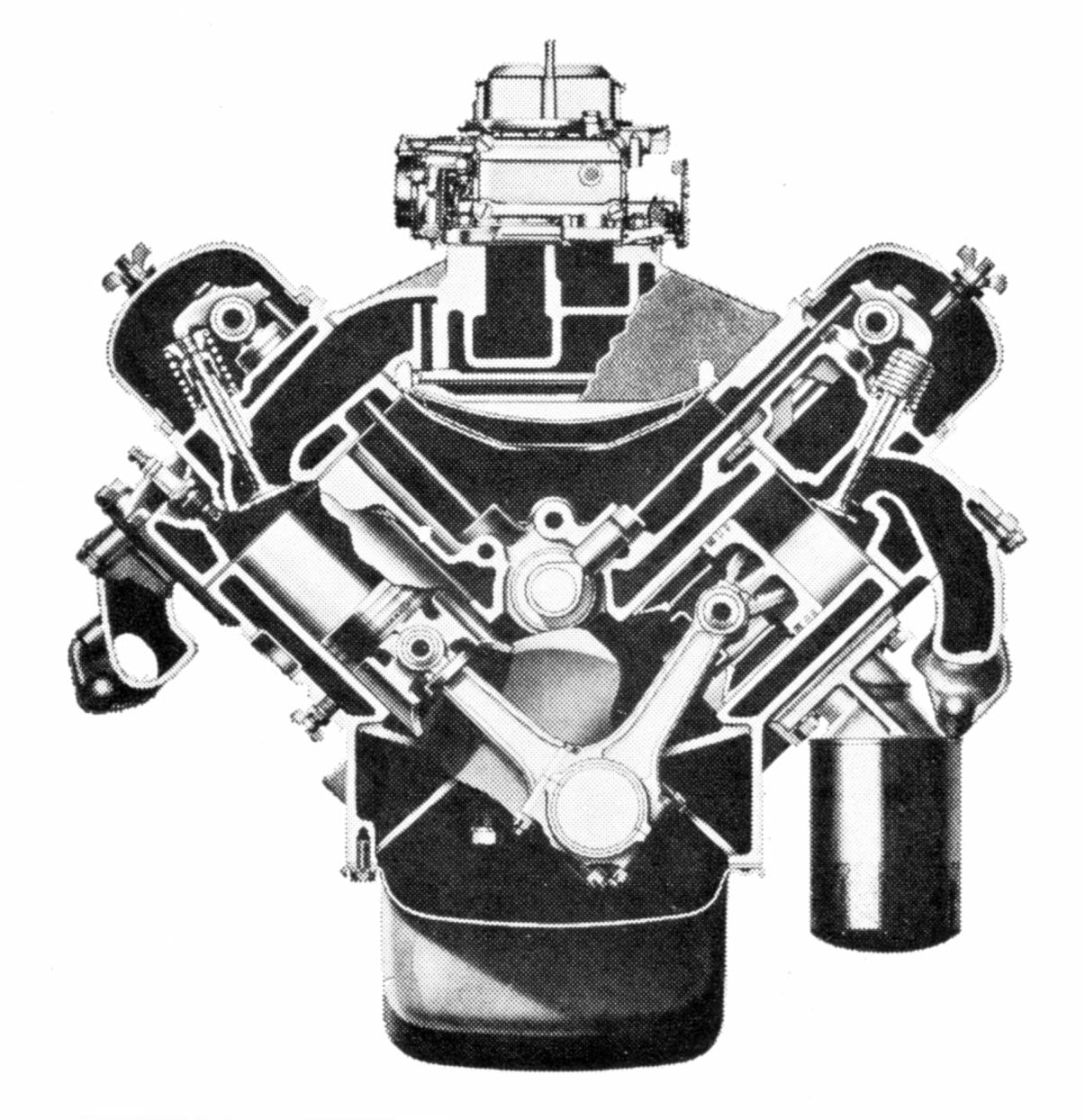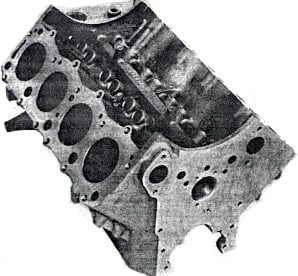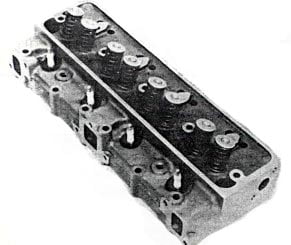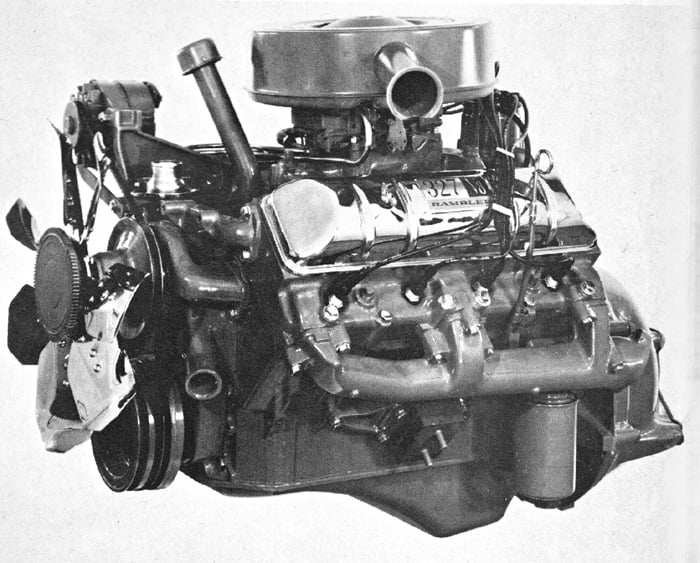How Did the AMC Generation 1 Engine Come to Be?
Details & Differences: Gen 1 AMC 250-327 V-8
In our History Section we detail how the engine was born out of necessity, but what we didn’t say was that AMC was very late to the OHV V8 party – so it was more than necessity – it was desperation. Nash Kelvinator was a company of dichotomies: first to offer modern, in-dash air conditioning, first to take real streamlining seriously in a quest for better mileage, first to try to meld interior roominess with modern styling – but last to see the value in a powerful V8 for their large size cars. By the time the mid-fifties rolled around, if you didn’t have an OHV V8 in your lineup, you were doomed to moribund sales. One of the major reasons for George Mason’s quest for a Packard merger was their engine and transmission technology.
When Packard informed Nash that it was going to “pull the plug” on the supply of their V8, by the end of 1956, AMC was caught without a viable alternative. Acquiring Hudson did not help as their aging 308 in-line six was reasonably powerful but heavy and at the end of its potential. Worse, there really wasn’t anyone on the powertrain engineering team with any OHV V8 knowledge, What to do?
Enter David Potter of the recently defunct Kaiser-Frazer Company. Potter was a powertrain engineer for Kaiser and had headed the team that had played with an experimental V8 of their own design; a 288 cu. in. unit primarily created Potter himself. At some point K-F decided it did not have the money to build this engine. At somewhere close to the same point in time, David Potter left Kaiser for a job at AMC, which neatly coincided with George Romey’s decision to build a new V-8. When interviewed about the K-F V8 in the 1970s, Potter was vague about whether he brought the design with him or just did something similar from scratch, but surviving pictures of the K-F 288 show an engine that appears identical to the first-generation AMC V8.
The speed of the new AMC V8’s development of less than 18 months from decision to production at a time where only testing could bear out paper design suggests that the Kaiser work was accepted as what would normally have been AMC’s preproduction process. It also suggests that AMC jumped on David Potter’s V8 quite literally as soon as they became aware of its existence.
The Mighty Mite 250
The first edition of this engine, at 250 cubic inches, appeared halfway through the 1956 model year in Nash Ambassador “Special” and Hudson Hornet “Special” models. The Specials were not only a lower trim level than the Packard-powered Ambassadors and Hornets, which remained in production but were seven inches shorter, as they used the Statesman (Rambler) chassis. To make a performance statement for their new engine, the AMC V8 went into what had been the shorter Nash Statesman/Hudson Wasp platform, which had been powered by Nash and Hudson sixes at that time.
The new V8 also used a GM Hydramatic transmission instead of the troublesome Packard Twin Ultramatic. (AMC had used Hydramatics behind its sixes, as both Nash and Hudson had done before their merger). By designing the bell housing to accept GM transmissions, AMC avoided being shoved into another tenuous supply situation as they had numerous divisions’ products to choose from – including independent Borg-Warner who made a unit that could be used by GM vehicles. (Early 1957s AMC V8s used GM Hydramatics, while a switch to Borg-Warner automatics took place somewhere in the middle of the model year).
Although the 250 V8 got a sneak preview in the Ambassador Special and Hudson Special of 1956, it was always intended as the Rambler V8. It was the smallest displacement passenger car V8 on the market in 1957, but its smaller size was not a handicap at all in the smaller Rambler, especially with its standard dual exhaust. Horsepower output in 2 barrel configuration was a more-than-respectable 190, the same rating as Ford’s entry-level 272 and higher in HP than the first two V8s on Chevy’s 1957 options list.
Next – a Bigger Bad Boy
But AMC wasn’t standing still. For a small company, they still had some chutzpah and had the larger 327 cu. in (4.0″ bore x 3.25″ stroke) waiting in the wings for the Ambassador and all of the Hudson line. The cover of the 1957 Hudson brochure announced “Power’s Up – Price’s Down”, and both claims were true. The big 1957 AMCs could be sold for less since the Company no longer had to pay Packard’s price for engines. And the 327 had 255 solid horsepower, a higher number than the previous year’s Packard V8 despite the Packard unit having 25 more cubic inches, ostensibly because Packard insisted that Hudson and Nash’s engines produce less horsepower than the virtually identical engine used in Clippers. This was accomplished by the use of thick head gaskets, which lowered the compression ratio on AMC engines, and the horsepower rating.
The big surprise took place in December of 1956 when AMC introduced the awesome Rambler “Rebel”, which combined the new 327 from the big cars with the smaller body of the Rambler four-door hardtop. Rebel 327s differed from the Ambassador/Hornet 327s by virtue of mechanical valve lifters and a higher compression ratio. (Some say a special cam was fitted, but the simple addition of a mechanical cam over the hydraulic, would effectively increase the duration as seen at the valve because there would be no cushioning of the cam ramps). The Rebel was supposed to be delivered with Bendix electronic fuel injection, but production problems in street trim precluded this. When the FI worked, the Rebel engine produced 288 HP, more than any engine in this size range!
But when the Ambassador 4-barrel carb was fitted instead of the FI, both the Rebel and the standard Ambassador engines were rated at 255 hp. it was assumed that if delivered, the FI would have been optional; it is surmised that the Rebel 4-barrel was slightly underrated, perhaps to make the stillborn 288 HP fuel-injection option appear to be more of an improvement.
It didn’t matter; in even 4-barrel trim the Rebel was a real screamer. Motor Trend magazine said the only 1957 model they tested that beat the 4-barrel Rebel’s 0-60 mph time was the Corvette with the fuel-injected 283. Even the mighty Chrysler 300C came in a tenth of a second behind the Rebel in 0-60 time. They knew that the 1957 Rebel was supposed to offer a Bendix “Electrojector” electronic fuel injection system, with its 288 horsepower, which Motor Trend believed would have proven even faster than the “fuelie” Corvette had it made it to production.
Regardless, by the end of 1957 and only 2 years after the decision to build their own V8, AMC had a modern, solid, dependable, and powerful engine that would soldier on for ten years in various forms.
AMC 250-327 V-8 Image 2
Early 250 cu. in. bare block. Aside from galleries that supplied oil for the 327’s hydraulic lifters, and except for the cylinder bore, both blocks were the same.
AMC 250-327 V-8 Image 3
Typical cylinder head. Both the 250, 287 and the 327 used the same valve sizes, ports, etc.
Engine Types
The 250
The 250 cu. in version was always intended for the lighter Rambler series. Its 3.50″ bore x 3.25″ stroke made for a smaller, more fuel-efficient design that still made good horsepower, likely because of good cylinder head design and rather large valves for such a small motor. It was fitted with 1.787″ intake and 1.406″ exhaust valve. It featured a forged crankshaft and rods, aluminum pistons, and a mechanical camshaft.
The base 250 cu. in. V8 advertised 190 hp 4900 rpm with a 2 bbl. carburetor and 8.0:1 compression ratio, it was later upped to 200 hp @ 4900 rpm because the compression was raised to 8.7:1. The later optional 215 hp 250 used a 4bbl. carburetor and the same 8.7:1 compression ratio, plus standard dual exhaust. Throughout its life, the 250 made between 240 and 260 ft. lbs. of torque. Its only major change occurred in 1959 when it adopted hydraulic lifters in place of the mechanical units from the 327.
The 250 was manufactured from 1956 through 1961 when it was removed from the lineup and there was no “small” GEN-1 V8 available for Ramblers, who had to soldier on with only a 6-cylinder until 1963. (George Romney at work).
The 287
After a multitude of complaints, and lost sales, in 1963 the 250 V8 was replaced by the GEN-1 287 cu. in. V8. It had a larger 3.75″ bore and the same 3.25″ stroke, with the same 1.787″ intake and 1.406″ exhaust valves. Except for the larger bore, the engine was basically the same as the previous offering. It had an 8.7;1 compression ratio, the same camshaft and hydraulic lifters as the last 250, and it was never fitted with a 4-barrel manifold, though dealers and backyard mechanics would have had no trouble bolting on either the 250’s or the 327’s unit and carb. From 1963 until it was phased out in late 1966, it had the same hp – 198 @ 4700 rpm, though its torque figure of 280 did exceed the max that the 250 had made even as a 4-barrel, dual exhaust engine.
The 287 was replaced by the GEN-2 290 engine in the Spring of 1966.
The 327
Surprisingly, the 327 cubic inch version of the GEN-1 block derived all of its horsepower and torque from nothing more than an increase in the cylinder bore. Its bore measured 4.000″, with the 250’s 3.25″ stroke. The 327 used exactly the same head design and even the same intake and exhaust valves at 1.787″ intake and 1.406″ respectively. These might have been considered small when compared to their use on the 250, but they seemed to add to the 327’s flat torque curve, making it an excellent engine for larger heavier vehicles like the Ambassador.
All components except for pistons, were the same as the 250 and 287 engines, except for the pistons, including the camshaft! In this iteration, the first edition of the 327 made at least 50 more horsepower and more importantly, 105 more ft. lbs. of torque. When equipped with a 2-barrel carb and single exhaust, as it was when delivered as an economic engine, the 327 only lost 20 horsepower and 20 ft. lbs of torque. David Potter’s design proved to be quite versatile and flexible.
As a measure of the 327’s prowess, the EFI Rebel engine produced close to 300 HP with nothing more than better induction and the mechanical cam from the first 250. Better yet, the engine never suffered any reliability problems or needs for upgrades, with the engine of 1966 being little changed from the one introduced in 1957. Few makers could make that claim. A quick look at the spec sheet will tell you that in its final iteration, the 327 had gained only a higher compression ratio a newer carburetor, and little else. It was reasonably powerful and reliable from start to finish.
The 327 was replaced by the GEN-2 343 cubic inch engine for the 1967 model year.
Big, Big, and Bigger
What is little known is that the GEN-1 block had the tooling capacity to receive a 4.125″ bore and a 4.000″ stroke for 427 cubic inches. The factory never produced this motor, but some enterprising drag racers in the period just before the introduction of the GEN-2 Motor did; with many boring the motor 0.060″ over and stroking it to 4.000″ for 418 inches! Port sizes were capable of supporting these larger sizes, but bigger valves needed to be fitted to take advantage of the added cubes. The GEN-2 block put an end to this speculation, because that engine was capable of enlargement to 440 cubic inches and had even better cylinder heads, plus was a much lighter, more modern design that out of the box outstripped the 327 in power and torque.
In summary, the 250 – 327 GEN-1 engine was a winner for AMC. It was more than paid for when it was retired, and though it was not radical in design nor designed as a race engine, it was an excellent design, likely ahead of its time when introduced.
AMC Engine Specifications from 1955 to 1966
| Year | Engine Cu. In. Carb Type Usage | Horespower @ RPM | ft.lbs. Torque @ RPM | Comp. Ratio | Bore Stroke | Rod Length | Intake Valve | Exhaust Valve |
| 1955 | Packard 320-28 | 208 @ 4200 | 300 @ 2000 | 7.8:1 | 3.8125" x 3.500" | |||
| 1956 | "Special" 250-2B | 190 @ 4900 | 240 @ 2500 | 8.0:1 | 3.500" x 3.250" | 6.375" | 1.787" | 1.406" |
| Packard 352-4B | 220 @ 4600 | 230 @ 2200 | 9.55:1 | 4.000" x 3.500" | ||||
| 1957 | 250-2B - Rambler | 190 @ 4900 | 240 @ 2500 | 8.0:1 | 3.500" x 3.250" | 6.375" | 1.787" | 1.406" |
| 327-4B - Ambassador | 250 @ 4900 | 345 @ 2600 | 9.0:1 | 4.000" x 3.250" | 6.375" | 1.787" | 1.406" | |
| 327-4B - Rebel | 255 @ 4900 | 345 @ 2600 | 9.5:1 | 4.000" x 3.250" | 6.375" | 1.787" | 1.406" | |
| 327-EFI* - Rambler | 288 @ 5200 | 350 @ 2800 | 9.5:1 | 4.000" x 3.250" | 6.375" | 1.787" | 1.406" | |
| 1958 | 250-2B - Rambler | 215 @ 4900 | 260 @ 2500 | 8.7:1 | 3.500" x 3.250" | 6.375" | 1.787" | 1.406" |
| 327-4B - Ambassador | 270 @ 4700 | 360 @ 2600 | 9.7:1 | 4.000" x 3.250" | 6.375" | 1.787" | 1.406" | |
| 1959 | 250-2B - Rambler | 215 @ 4900 | 260 @ 2500 | 8.7:1 | 3.500" x 3.250" | 6.375" | 1.787" | 1.406" |
| 327-4B - Ambassador | 270 @ 4700 | 360 @ 2600 | 9.7:1 | 4.000" x 3.250" | 6.375" | 1.787" | 1.406" | |
| 1960 | 250-2B - Rambler | 200 @ 4900 | 245 @ 2500 | 8.7:1 | 3.500" x 3.250" | 6.375" | 1.787" | 1.406" |
| 250-4B - Rambler | 215 @ 4900 | 260 @ 2500 | 8.7:1 | 3.500" x 3.250" | 6.375" | 1.787" | 1.406" | |
| 327-2B - Ambassador | 250 @ 4700 | 340 @ 2600 | 8.7:1 | 4.000" x 3.250" | 6.375" | 1.787" | 1.406" | |
| 327-4B - Ambassador | 270 @ 4700 | 360 @ 2600 | 9.7:1 | 4.000" x 3.250" | 6.375" | 1.787" | 1.406" | |
| 1961 | 250-2B - Rambler | 200 @ 4900 | 245 @ 2500 | 8.7:1 | 3.500" x 3.250" | 6.375" | 1.787" | 1.406" |
| 327-2B - Ambassador | 250 @ 4700 | 340 @ 2600 | 8.7:1 | 4.000" x 3.250" | 6.375" | 1.787" | 1.406" | |
| 327-4B - Ambassador | 270 @ 4700 | 360 @ 2600 | 9.7:1 | 4.000" x 3.250" | 6.375" | 1.787" | 1.406" | |
| 1962 | 327-2B - Ambassador | 250 @ 4700 | 340 @ 2600 | 8.7:1 | 4.000" x 3.250" | 6.375" | 1.787" | 1.406" |
| 327-4B - Ambassador | 270 @ 4700 | 360 @ 2600 | 9.7:1 | 4.000" x 3.250" | 6.375" | 1.787" | 1.406" | |
| 1963 | 287-2B - Classic | 198 @ 4700 | 280 @ 2600 | 8.7:1 | 3.750" x 3.250" | 6.375" | 1.787" | 1.406" |
| 327-2B - Ambassador | 250 @ 4700 | 340 @ 2600 | 8.7:1 | 4.000" x 3.250" | 6.375" | 1.787" | 1.406" | |
| 327-4B - Ambassador | 270 @ 4700 | 360 @ 2600 | 9.7:1 | 4.000" x 3.250" | 6.375" | 1.787" | 1.406" | |
| 1964 | 287-2B - Classic | 198 @ 4700 | 280 @ 2600 | 8.7:1 | 3.750" x 3.250" | 6.375" | 1.787" | 1.406" |
| 327-2B - Ambassador | 250 @ 4700 | 340 @ 2600 | 8.7:1 | 4.000" x 3.250" | 6.375" | 1.787" | 1.406" | |
| 327-4B - Ambassador | 270 @ 4700 | 360 @ 2600 | 9.7:1 | 4.000" x 3.250" | 6.375" | 1.787" | 1.406" | |
| 1965 | 287-2B - Classic & Marlin | 198 @ 4700 | 280 @ 2600 | 8.7:1 | 3.750" x 3.250" | 6.375" | 1.787" | 1.406" |
| 327-4B - Ambassador; Marlin Optional | 270 @ 4700 | 360 @ 2600 | 9.7:1 | 4.000" x 3.250" | 6.375" | 1.787" | 1.406" | |
| 1966 | 287-2B - All Std | 198 @ 4700 | 280 @ 2600 | 8.7:1 | 3.750" x 3.250" | 6.375" | 1.787" | 1.406" |
| 327-2B - Ambassador Std. All others Optional | 250 @ 4700 | 340 @ 2600 | 8.7:1 | 4.000" x 3.250" | 6.375" | 1.787" | 1.406" | |
| 327-4B - Ambassador Std. All others Optional | 270 @ 4700 | 360 @ 2600 | 9.7:1 | 4.000" x 3.250" | 6.375" | 1.787" | 1.406" |









